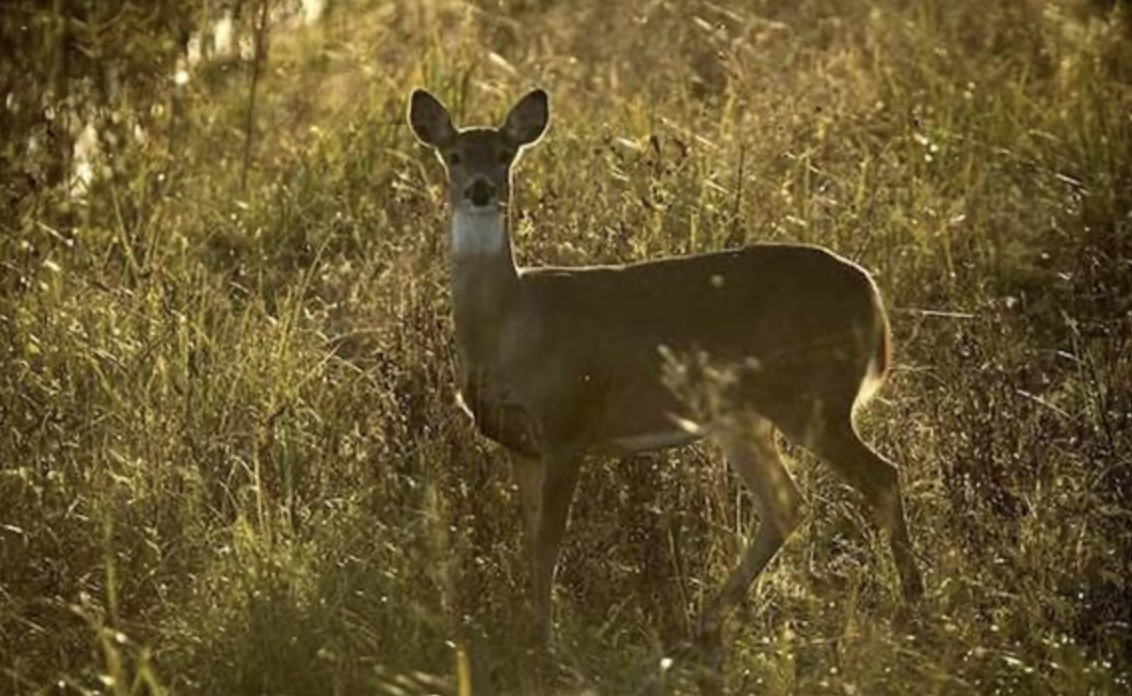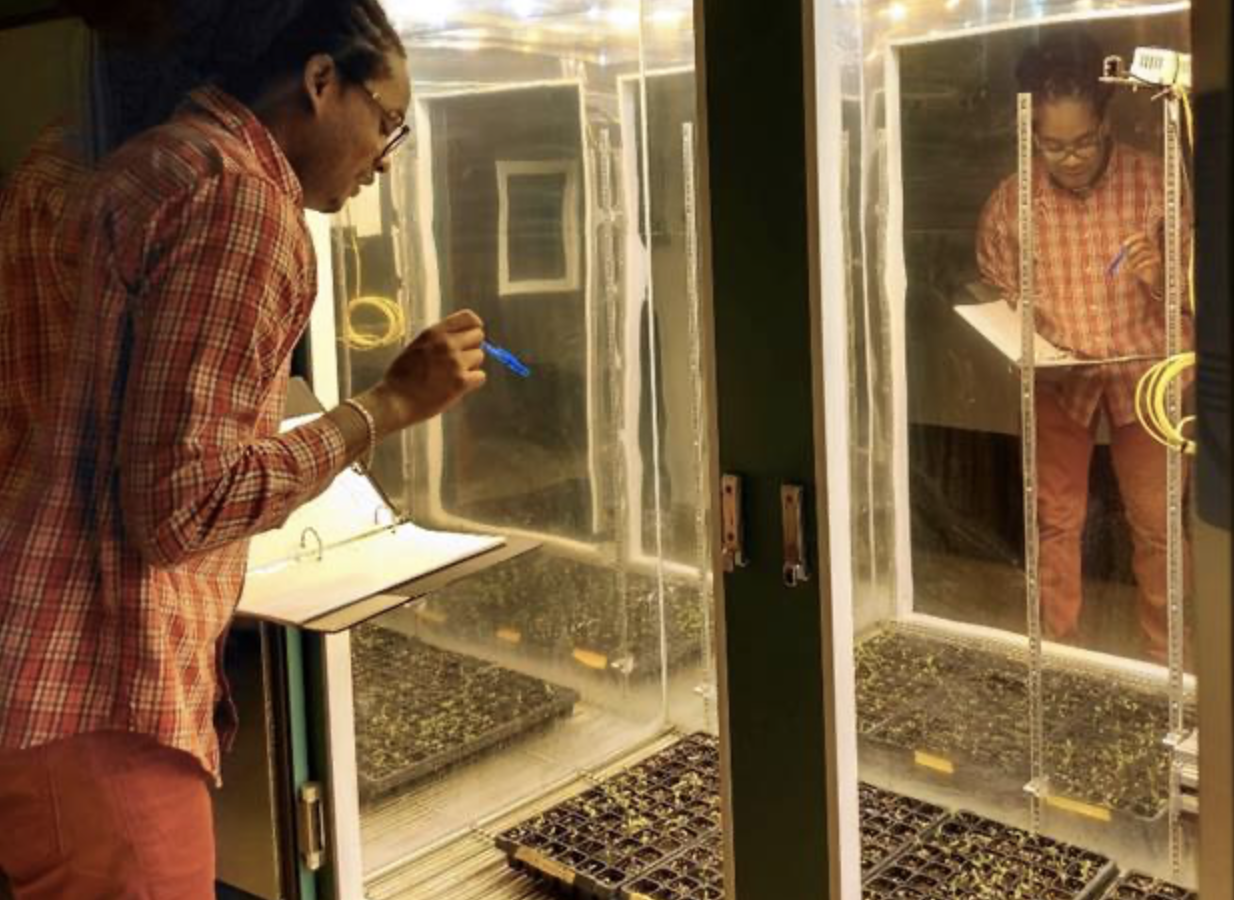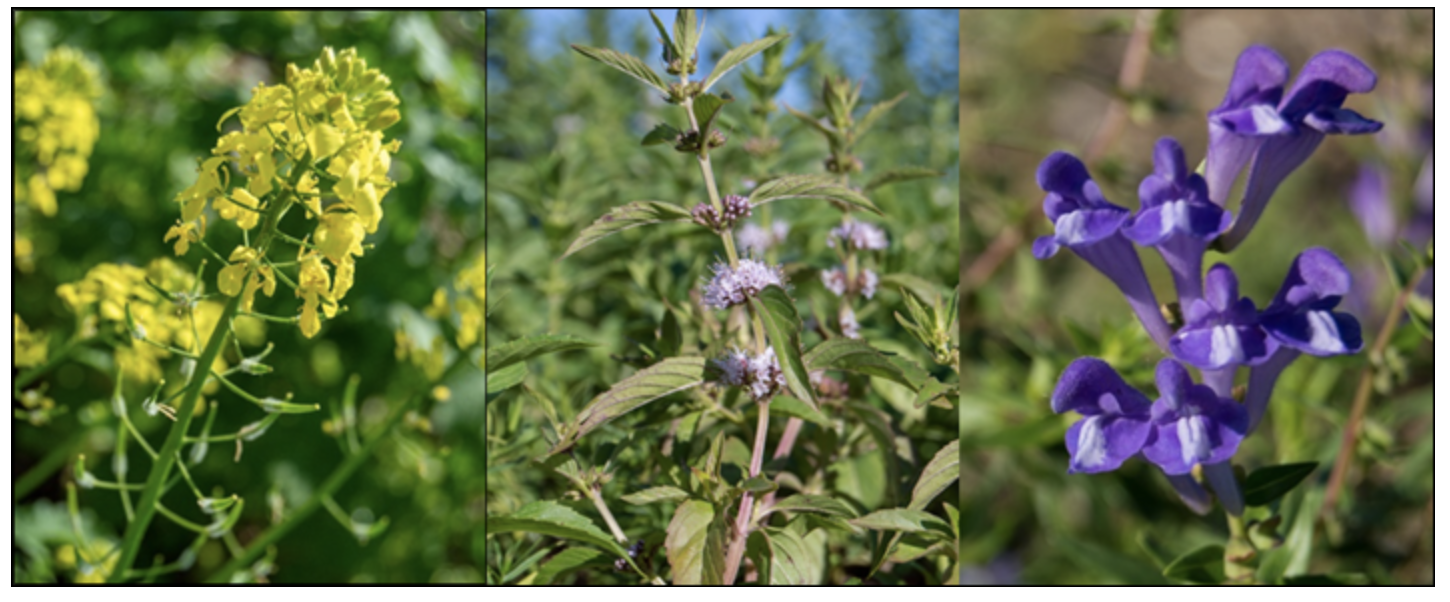Understanding Our Environment

February 2021 Issue
Understanding Our Environment is the internal newsletter for the Kansas Biological Survey & Center for Ecological Research community. Please email biosurvey@ku.edu regarding any errors or omissions.
Photo: Roth Trailhead at the KU Field Station (Vaughn Salisbury/Kansas Biological Survey).
One Day. One KU. is February 18
KU Endowment’s annual one-day university-wide fundraising campaign, “One Day. One KU.” is coming up on Thursday, Feb. 18. The Kansas Biological Survey has a special giving page where anyone can make a donation online on that one day. Sara Baer, Bio Survey director, will match all donations up to $1,000. Last year we raised $8,000. You’ll get reminder emails about this over the coming week, but please be aware that this is coming, give if you wish, and please share this information and our shortlink — https://rockcha.lk/odoku21-biosurvey — to anyone you believe would like to help by forwarding the reminder emails, sending your own emails, or sharing the social media posts that will be on our Twitter and Facebook pages. Thank you!
Comings and Goings
We welcome several new faces as the spring semester begins.
Arielle Mollhagan joins the Billings Lab as lab manager (Sharon Billings(Billings Lab) is a senior scientist at the Kansas Biological Survey and Deans Professor of Ecology and Evolutionary Biology).
The Bever/Schultz lab has added three new members:
- Aaron Baumgardener, research technician;
- Alexa Phillips, molecular research assistant; and
- Madison Tunnel, molecular research assistant.
(Jim Bever is a senior scientist at the Bio Survey and Foundation Distinguished Professor of Ecology and Evolutionary Biology. Peggy Schultz is an associate specialist at the Bio Survey and in the Environmental Studies Program.)
Nichole Ginnan, postdoctoral researcher, has joined Maggie Wagner’s lab to work with Maggie on her National Science Foundation-funded project funded earlier this year. Nichole completed the Ph.D. in plant pathology at the University of California-Riverside. Learn more about her previous work by visiting her website. (Maggie is an assistant scientist at the Bio Survey and an assistant professor of ecology and evolutionary biology.)
We also send our best wishes with three departing members of the Bever/Schultz Lab: Dana Carpenter, research technician; Guangzhou Wang, postdoctoral researcher; and Austin Yoder, molecular Research Assistant.
Grants
Ligia Souza, doctoral student in the Billings Laboratory, has been awarded a grant from the Doctoral Student Research Fund in the Office of Graduate Studies for her project titled, “How future nutrient availability depends on the temperature response of soil enzymes.” The funds will cover supplies for the project. Sharon Billings, her advisor, is a senior scientist at the Bio Survey and Dean’s Professor of Ecology and Evolutionary Biology.
Publications
Camille Delavaux, Maggie Wagner and Jim Bever are co-authors of a letter in the journal New Phytologist, “Utility of large subunit for environmental sequencing of arbuscular mycorrhizal fungi: a new reference database and pipeline.” Camille is a doctoral student in the Bever/Schultz Lab. Maggie is an assistant scientist at the Bio Survey and an assistant professor of ecology and evolutionary biology.
Ted Harris is co-author on a recently published study that took place at the KU Field Station. The article, “Phytoplankton Community Response to Changes in Light: Can Glacial Rock Flour Be Use to Control Cyanobacterial Blooms?” is in the journal Frontiers in Environmental Science, with lead author Jacob Gaskill and co-author Rebecca North, both from the University of Missouri, Columbia. Ted is an assistant research professor at the Bio Survey.
Jacob Hopkins, Tanya Semenova-Nelsen and Ben Sikes have just had a paper, “Fungal community structure and seasonal trajectories respond similarly to fire across pyrophilic systems,” accepted by the journal FEMS Microbiology Ecology. The work shows that, in both tallgrass prairie and pine savanna, fires alter the seasonal trajectories of soil fungal communities. The prairie work was conducted at the KU Field Station, including the Dogleg and Rockefeller prairies. Ben is an associate scientist at the Bio Survey and an associate professor of microbial ecology. Jacob is a doctoral student in the Sikes Microbial Lab. Tanya formerly was a postdoctoral researcher in the Sikes Lab and is now a scientist at WuXi AppTex in Philadelphia.
Kelly Kindscher has a new publication, “The Vascular Plants of Lake Roberts, Gila National Forest, Grant County, New Mexico” (attached), in the journal New Mexico Botanist. Kelly is a senior scientist at the Bio Survey and a professor in the Environmental Studies Program.
Dan Reuman’s research for his paper in Ecology Letters, “Synchronous effects produce cycles in deer populations and deer-vehicles collisions,” was publicized in late January in KU Today. Dan is a senior scientist at the Bio Survey and a professor of ecology and evolutionary biology. Co-author Lawrence Sheppard is a postdoc in the Reuman Lab; co-authors Tom Anderson and Jon Walters are former postdocs.

Christopher Rogers, Bio Survey assistant research professor, several new publications:
- in the Journal of Crustacean Biology, “A review of Triops granarius (Lucas, 1864) sensu lato (Notostraca: Triopsidae) of southern Africa and Madagascar, with comments on the group.”
- in the journal Water, “A review of recently discovered remains of the Pleistocene branchiopods (Anostraca, Notostraca) from NE Siberia and Arctic Canada.”
- in the Journal of Crustacean Biology (attached), “Raman spectroscopic analysis of the composition of the clam-shrimp carapace (Branchiopoda: Laevicaudata, Spinicaudata, Cyclestherida): a dual calcium phosphate-calcium carbonate composition,” with Thomas Hegna of SUNY-Fredonia and Andrew Czaja of the University of Cincinnati;
- in the journal Water (attached; image below), “Pleistocene Branchiopods (Cladocera, Anostraca) from Transbaikalian Siberia Demonstrate Morphological and Ecological Stasis,” with five colleagues at the Russian Academy of Sciences;
- his book, Recent Advances in Freshwater Crustacean Biodiversity and Conservation, with co-editor Tadashi Kawai, chief researcher at the Hokkaido Research Organization, Central Fisheries Research Institution, Japan.
Jim Thorp, Bio Survey senior scientist and professor of ecology and evolutionary biology, has published three papers in the February issue of Frontiers in Ecology and the Environement, in an issue focused on macrosystems:
- “Macrosystems as metacoupled human and natural systems”;
- “The evolution of macrosystems biology”;
- “Multi-scale biodiversity drives temporal variability in macrosystems”
A fourth article, “Ecological thresholds and regime shifts with hydrologically modified rivers: A 75+ year retrospective analysis,” was published in River Research and Applications. And a fifth, “A framework for lotic macrosystem research,” was published in Ecosphere; co-authors are Caleb Robbins, former postdoc in the lab; Emily Arsenault, doctoral student; Jackob Lutcheon, research technician, and Greg Mathews, former graduate student in the lab. All papers are will be added to the website shortly.
Guangzhou Wang, former postdoctoral researcher in the Bever/Schultz Lab, published an article, “Soil microbiology legacy drives crop diversity advantage: Linking ecological plant-soil feedback with agricultural intercropping,” in the journal Applied Ecology. It discusses the potential for the soil microbiome to mediate over yielding in mixed cropping systems. Peggy Schultz and Jim Bever are co-authors.
Awards and Honors
Sharon Billings and Kelly Kindscher each received a 2021 Higuchi-KU Endowment Research Achievement Award, the state higher education system’s most prestigious recognition for scholarly excellence. They are two of four recipients, which of course means that the Kansas Biological Survey had representation among half the awards. Each receives $10,000 for their ongoing research. They will be recognized in April along with recipients of other major KU research awards. Kelly is a senior scientist at the Bio Survey and a professor in the Environmental Studies Program.
Laura Phillips, a senior from Perry, Kansas, mentored by Maggie Wagner, was one of 41 students selected for a 2021 KU Undergraduate Research Award. Each recipient receives a $1,000 scholarship. Laura’s research proposal is titled: “Drought Tolerance on B73 Maize in Response to Microbiome Inoculations.”
Rondy Malik, postdoctoral researcher in the Bever/Schultz Lab, was named a “Rising Star” on a list of “1,000 inspiring Black scientists in America” published by Cell Mentor at the end of December. KU published a profile of Rondy last week in KU Today.

Publicity
Chip Taylor is among several experts interviewed for the Smithsonian Magazine article, “Why Monarch Butterflies Aren’t Getting Endangered Species Status.”
Sharon Billings, whose research includes emphasis on Earth’s critical zones, shares that The New York Times included the book Critical Zones in its selection of best art books for 2020. Sharon co-wrote one of the book’s chapters. You have to scroll down in the link a bit to find the summary, so here it is:"‘CRITICAL ZONES: THE SCIENCE AND POLITICS OF LANDING ON EARTH’ Edited by Bruno Latour and Peter Weibel (MIT/ZKM Center for Art and Media, Karlsruhe). Climate change should furnish to art what Galileo delivered to theology: a definitive rupture of where we think we stand. The giant catalog for this German exhibition unites philosophers, scientists, historians and artists (from Caspar David Friedrich to Sarah Sze) to re-anchor art inside a constantly transforming ecosystem. The old “Blue Marble” won’t cut it; we need new methods of depicting Earth and its landscapes that account for our codependency with all species. After all, as the editors write, aesthetics is ‘what renders one sensitive to the existence of other ways of life.'”
Outreach
Ben Sikes recently did a virtual outreach event for the Independence (Kansas) Public Library for KU Natural History Museum’s Microbes on the Move. He led a walk in the woods and talked about fungi then brought samples back and looked at them through a microscope at his home.
Peggy Schultz, along with Terra Lubin and other project team members, are creating a new series of environmental videos, “Ecosystems of Kansas,” for elementary students, which are posted on Facebook and YouTube for use by teachers and parents. The videos meet K-12 Next Generation Science Standards (NGSS) developed by the State of Kansas and are available in both English and Spanish language versions. The first two videos have been posted on the Bio Survey’s YouTube channel. The project is part of the outreach component of the larger $20M National Science Foundation-funded project known as MAPS: Microbiomes of Aquatic, Plant, and Soil Systems across Kansas. Peggy is a Bio Survey researcher and a faculty member in KU’s Environmental Studies Program. Terra is a postdoctoral researcher in the Bever/Schultz Laboratory.
KU Field Station
Jennifer Delisle, Bio Survey researcher, has created a list of fungi for the Rice Tract of the KU Field Station’s Baldwin Woods Forest Preserve from surveys conducted this year by Sherry Kay and Ben Sikes. Scientists hope to compare these species (below, Cortinarius coloratus) to those identified following a prescribed burn planned for 2021 in conjunction with the Kansas Forest Service. In the longer time frame, the team hopes to digitize the many years of records for mushrooms at the Breidenthal Tract of the Preserve by Sherry and Skip Kay and the Kaw Valley Mycological Society.
Behind the Scenes
For nearly six decades, Henry Fitch, KU professor and namesake of the KU Field Station’s Fitch Natural History Reservation, conducted extensive field work on snakes there beginning in 1948. He died in 2009 and left as a legacy handwritten data sheets with approximately 60,000 capture records. George Pisani, a biologist at KU and later at the Bio Survey, collaborated with Fitch on some ecological studies. Beginning about 2005, Pisani began the years-long process of converting Fitch’s records of snake captures into an electronic database. This work was funded in part by the Kansas Dept. of Wildlife, Parks and Tourism Chickadee Checkoff program. Now, through the efforts of Jennifer Delisle, Bio Survey researcher, these records have been published on the Environmental Data Initiative’s EDI Data Portal and are available to researchers everywhere.
Bio Survey researcher Jennifer Moody and Kelly Kindscher submitted their report in December to an herbal products company with whom they had contracted to obtain plant materials for 18 different plant species. Pictured below are three of the plants grown in summer 2020 at the KU Native Medicinal Plant Garden, a KU Field Station site. Left to right: white mustard (Sinapsis alba), wild mint (Mentha canadensis) and Chinese skullcap (Scutellaria baicalensis). 
Beyond KU
Bio Survey researcher Debbie Baker has been able to finish the Bio101 class she was teaching at Université de la Communauté Chrétienne de Caïman in Haiti, which was interrupted in March by the outbreak of the COVID-19 pandemic. The class was resumed through pre-recorded PowerPoint videos that her assistant, Elio, used to teach. Debbie says that COVID is not as widespread in Haiti as in the U.S. and that students finished the spring semester in October. She will continue to teach remotely for Bio102.